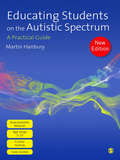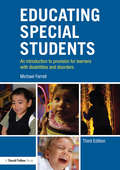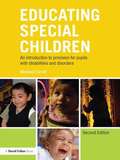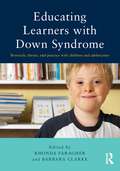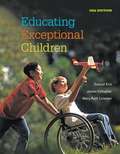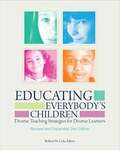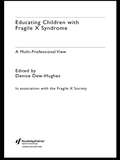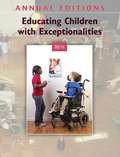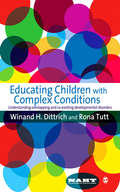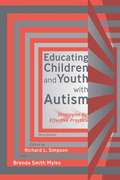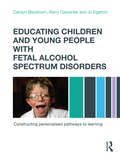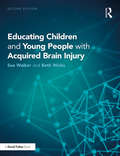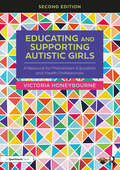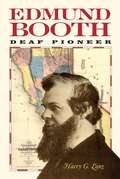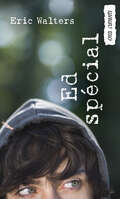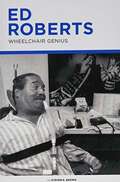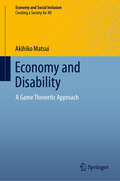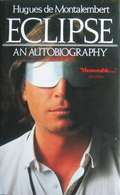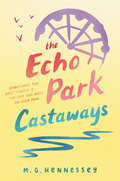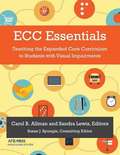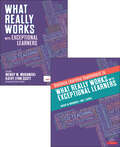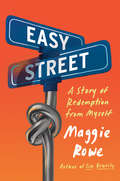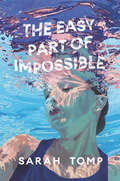- Table View
- List View
Educating Students on the Autistic Spectrum: A Practical Guide
by Dr Martin HanburyThe aim of this book is to make sure all students on the Autistic Spectrum are given the opportunity to engage in appropriate teaching and learning experiences. It considers the individual with autism, and offers tried and tested approaches that have worked, giving background information on autism and its impact on the learner. In this new edition, the author has added: - more information on sensory issues - an increasingly holistic view of the student with autism - new ideas for curriculum planning in mainstream settings - advice on multi-professional working - guidance on developing positive working relationships with parents and carers There is a wealth of new electronic material available to download from the SAGE website, including photocopiable materials, PowerPoint presentations and checklists. A must-have resource for all practitioners working with children and young people on the autistic spectrum, this book will improve your inclusive practice and ensure positive outcomes for these children.
Educating Special Students: An introduction to provision for learners with disabilities and disorders
by Michael FarrellEducating Special Students is the definitive guide to evidence based practice and professionally informed approaches to provision for special students. Now in its third edition, the book sets out ideas of best practice relating to different disabilities and disorders, helpfully discussing what might constitute effective provision. This edition has been updated to take account of new ways of classifying disabilities and disorders, and recent developments in research and practice, including the 2014 SEND Code of Practice (England) and the Diagnostic and Statistical Manual of Mental Disorders Fifth Edition DSM-5TM. A new appendix provides information on basic anatomy and physiology. International in scope, the book explores issues relating to: intellectual disability (profound, moderate to severe, and mild) sensory impairments orthopaedic impairment and motor disorders, health impairments, and traumatic brain injury oppositional defiant disorder, conduct disorder, anxiety disorders, depressive disorders, and attention deficit hyperactivity disorder communication disorders (speech, grammar and comprehension, semantics and pragmatics), and autism spectrum disorder specific learning disorders with impairment in reading, written expression and mathematics, and developmental co-ordination disorder. Educating Special Students will be of interest to all those studying special education, professionals, and others committed to seeking the best provision for special students.
Educating Special Children: An introduction to provision for pupils with disabilities and disorders
by Michael FarrellEducating Special Children is the definitive guide to evidence-based practice and professionally informed approaches in provision for special children. Now in its second edition, this book outlines ideas of best practice that relate to various disabilities and disorders and helpfully discusses what might constitute effective provision. International in its scope, it explores issues surrounding: communication disorders and autism and Asperger's Syndrome developmental co-ordination disorders reading, writing and mathematics disorders disorders of conduct, anxiety and depression attention deficit hyperactivity disorder mild, moderate to severe, and profound cognitive impairment sensory impairments orthopaedic and motor disabilities, health impairments and traumatic brain injury. This new edition has also been updated to cover: entitlement to special education global examples of distinctive provision raising standards in your setting basic brain anatomy and physiology 'thinking points' and further reading list for reflection. Educating Special Children will be of interest to all students of special education, professionals and others interested in gaining an understanding in the challenging field of offering provision for special children.
Educating Learners with Down Syndrome: Research, theory, and practice with children and adolescents
by Barbara Clarke Rhonda FaragherFor individuals with Down syndrome, the extent of the effect of intellectual disability depends largely on the degree of provision of appropriate support and intervention. In Educating Learners with Down Syndrome, editors Rhonda Faragher and Barbara Clarke have brought together a number of expert contributors, whose chapters review recent findings in the field of DS education, highlight promising practices, and identify areas for future research. While the emphasis is primarily on the school years, links to early intervention and to life post-16 are made, with chapters organized into three parts: conceptual overview of issues in learning and teaching, learning mathematics, and literacy development. The book is also united by the cohesive themes of assessment, evidence-based practice, and inclusive practices. Educating Learners with Down Syndrome importantly incorporates the voices of individuals with Down syndrome, whose personal narratives add significance to the research mission of the text and demonstrate the authors' inclusive philosophy. Aimed at researchers, teacher educators, higher degree students, and policy makers, this book is the first of its kind to provide a compendium of research on educating learners with Down syndrome.
Educating Exceptional Children
by Samuel Kirk Mary Ruth Coleman James J. GallagherAuthored by luminaries in the special education field, EDUCATING EXCEPTIONAL CHILDREN introduces readers to each of the thirteen disability categories, and to the needs of children who are gifted and talented. The fourteenth edition continues to focus on the strengths of previous editions, while also providing new material about such important hot topics as genetics, neurology, inclusion, assistive technology, and information processing. The book provides key, research-based teaching methods and strategies for children with various exceptionalities, and also offers analysis of ecological factors that influence the exceptional child in and out of the classroom. This edition also features a new chapter on children with ADD/ADHD, new diagnosis information from the DSM-5, coverage of CEC and Common Core State Standards, the most current teaching techniques for each category, and current coverage of the Response to Intervention Model.
Educating Everybody's Children: Diverse Teaching Strategies for Diverse Learners
by Robert W. ColeDesigned to promote reflection, discussion, and action among the entire learning community, Educating Everybody's Children encapsulates what research has revealed about successfully addressing the needs of students from economically, ethnically, culturally, and linguistically diverse groups and identifies a wide range of effective principles and instructional strategies. <p><p> Although good teaching works well with all students, educators must develop an extensive repertoire of instructional tools to meet the varying needs of students from diverse backgrounds. Those tools and the knowledge base behind them are the foundation of this expanded and revised second edition of Educating Everybody's Children. Each strategy discussed in the book includes classroom examples and a list of the research studies that support it. <p><p> The most important thing we have learned as a result of the education reform movement is that student achievement stands or falls on the motivation and skills of teachers. We must ensure that all teachers are capable of delivering a standards‑based curriculum that describes what students should know and be able to do, and that these standards are delivered by means of a rich and engaging "pedagogy of plenty." By these two acts we can ensure that all schools will be ready and able to educate everybody's children.
Educating Children with Fragile X Syndrome: A Multi-Professional View
by Denise Dew-HughesWhat is Fragile X? The most common inherited cause of learning difficulties, affecting a child's ability to tackle key areas such as literacy and numeracy, and causing behaviour problems and social anxiety. What can teachers do to help children with Fragile X become more effective learners? This definitive text will provide essential support and information for teachers with the expertise of an international field of researchers, whose variety of perspectives contribute to a unique, multi-professional approach. Each chapter of the book suggests practical intervention strategies, based on sound educational principles expressed in clear non-specific terms. A range of important topics are considered, including: * the physical and behavioural characteristics of Fragile X* the effects of Fragile X on learning* medication and therapy* related conditions such as autism and attention deficit disorders. Breaking down the barriers of professional practice, this book establishes the groundwork for successful and valuable multi-professional teamwork. By providing immediate access to a body of empirical knowledge and advice from other disciplines, it will encourage teachers to incorporate this approach into their own practice. Everyone responsible for the education of a child with Fragile X syndrome should read this book.
Educating Children with Exceptionalities 10/11 (20th edition)
by Karen L. FreibergThe Annual Editions series provides students with convenient, inexpensive access to current, carefully selected articles from the public press. Annual Editions: Educating Children with Exceptionalities 10/11 is an easy-to-use reader that presents articles on important topics such as fitting in, severe disabilities, gifted and talented, and many more.
Educating Children with Complex Conditions: Understanding Overlapping & Co-existing Developmental Disorders
by Dr Rona Tutt Dr Winand H Dittrich'This is an important contribution to the field of SEN. By putting the child into a context, the authors recognize that each child is unique and cannot be reduced to a simple diagnosis. Highly recommended' - SEN Magazine 'In just over 100 pages this book gives the clearest account I have yet read of 'overlapping and co-existing conditions'....All professionals working with children with complex conditions will find it both interesting and practical' - Special 'The book is written in an easily digestible form, and provides insight into overlapping conditions as well as advice on support to those working to meeting the needs of pupils with these complex disorders' - SNIP 'Many have tried but few have succeeded in bringing together the varying threads of special educational needs into a concise and proactive format. I know, having tried and failed myself. Here at last Dittrich and Tutt have created a fascinating account of the current SEN world and have succeeded, in my opinion, in demystifying and explaining the significance of specific SEN terms, while illustrating that overlap is more the norm than the exception. Well researched and written with both clarity and experience, the authors stress that there really is no such thing as a SEN child, but that some children are in essence more interesting in their learning and behaviour style than others.' Fintan O'Regan, Author and Consultant There are growing numbers of children displaying the symptoms of more than one condition or disorder, and this has led to those involved in education needing to understand which conditions commonly overlap or co-exist, and how to meet children's more complex needs. By bringing together some of the latest research on how the brain learns with what is known about identifying developmental disorders that appear to have a common biological basis, this book covers: - what is known about a common group of disorders, (including ADHD, autistic spectrum disorders, dyslexia, dyscalculia and dyspraxia) - how to recognise when a child may have more than one condition - what teaching approaches and strategies might be most relevant Written in a non-technical style, the book blends together scientific knowledge from different disciplines and translates it into practical terms for school leaders, practitioners in the field of special educational needs and disabilities, and students following courses in higher education.
Educating Children And Youth With Autism: Strategies For Effective Practice
by Richard L. Simpson Brenda Smith MylesChildren and youth with autism spectrum disorders (ASD) have highly distinctive and idiosyncratic needs and characteristics. ASD is an especially challenging and perplexing disability. The need for knowledgeable and skilled educational professionals was the primary motivation for preparing this third edition of Educating Children and Youth With Autism: Strategies for Effective Practice. This edition includes chapters written by internationally recognized authorities on ASD.
Educating Children and Young People with Fetal Alcohol Spectrum Disorders: Constructing Personalised Pathways to Learning
by Barry Carpenter Jo Egerton Carolyn BlackburnThe range of learning difficulties associated with children who have fetal alcohol spectrum disorders (FASDs) has been highlighted as an emerging but little understood area of Special Educational Needs. This engaging, timely, and highly practical book will raise awareness about FASDs and their associated difficulties across the entire education workforce. It provides a range of specialist, practical tried-and-tested teaching and learning strategies, from which teachers and support staff may construct personalised learning plans for students with FASDs, and will help improve outcomes for all their children. It also: explains the impact that FASDs can have on the child’s brain; discusses the overlapping and co-existing disorders, such as ADHD and autism spectrum disorders; shows how to support and empower teachers; provides ready-to-use teaching resources and strategies that can be used directly in the classroom. Informed by the very latest research and written by leading experts in the field, Educating Children and Young People with Fetal Alcohol Spectrum Disorders will prove invaluable for experienced teachers and teaching assistants who are engaging in Continuing Professional Development, as well as newly qualified and training Initial Teacher Training students.
Educating Children and Young People with Acquired Brain Injury
by Sue Walker Beth WicksEducating Children with Acquired Brain Injury is an authoritative resource book on the effects of brain injury on young people and how educators can understand and support their needs. This new edition has been updated to reflect changes to legislation and practice relating to special educational needs and will enable you to maximise the learning opportunities for young people with acquired brain injury (ABI). Considering key areas in special educational needs such as communication, interaction, cognition, sensory and physical needs, the book provides information on the multifaceted needs of children and young people with ABI and how these needs can be met. This book will help you to: Understand the difficulties that young people with ABI experience Support these students by using appropriate strategies to help their learning Understand and address the social and emotional difficulties experienced by these students Work in partnership with families and other professionals Understand information from other professionals by reference to a glossary of terms Access further useful information from relevant resources and organisations Written for SENCOs, teachers, teaching assistants, educational psychologists and other education professionals across all settings, Educating Children with Acquired Brain Injury is full of useful information and advice for parents and other family members, clinical and behavioural psychologists, therapists and support workers involved with children and young people with ABI.
Educating and Supporting Autistic Girls: A Resource for Mainstream Education and Health Professionals
by Victoria HoneybourneAutistic girls, especially those educated in mainstream environments, have often been missed or misdiagnosed. There is now, however, greater awareness of how autism can present in females, why these girls can remain ‘invisible’, and what education and health professionals can do to provide better support. Fully revised and updated, this practical book shines a light on the insights, opinions and experiences of autistic girls and women, providing a rich insight into school life from an autistic perspective. It explores the difficulties and disadvantages that autistic girls can face in educational settings and offers guidance on how to best support them, with a wealth of strategies reflecting good practice in the field of autism and education. The resource also contains a broad range of worksheets and activities on key issues and includes new sections on anxiety, masking, home life, social media, gender and sexual identity. Key features include: A wealth of case studies to illustrate different topics Guidance on best practice when working with autistic girls New audits to help staff and pupils to identify strengths and areas to improve Easy-to-implement strategies and tips to help professionals adapt to environments and policies for autistic students Activities and resources for young autistic females to support them in developing self-awareness, coping strategies and learning skills With the voices of autistic girls and young women woven throughout, drawing upon their experiences of education – from learning and communication, to friendships, transitions and interpreting the world – this is an essential resource for education and health professionals working with autistic girls, particularly in mainstream environments.
Edmund Booth: Deaf Pioneer
by Harry G. LangEdmund Booth was born in 1810 and died in 1905, and during the 94 years of his life, he epitomized virtually everything that characterized an American legend of that century. In his prime, Booth stood 6 feet, 3 inches tall, weighed in at 210 pounds, and wore a long, full beard. He taught school in Hartford, CT, then followed his wife-to-be Mary Ann Walworth west to Anamosa, Iowa, where in 1840, he built the area's first frame house. He pulled up stakes nine years later to travel the Overland Trail on his way to join the California Gold Rush. After he returned to Iowa in 1854, he became the editor of the Anamosa Eureka, the local newspaper. Edmund Booth fit perfectly the mold of the ingenious pioneer of 19th-century America, except for one unusual difference -- he was deaf. Edmund Booth: Deaf Pioneer follows the amazing career of this American original and his equally amazing wife in fascinating detail. Author Harry G. Lang vividly portrays Booth and his wife by drawing from a remarkable array of original material. A prolific writer, Booth corresponded with his fiancé from the American School for the Deaf in Hartford, and he kept a journal during his days on the California trail, parts of which have been reproduced here. He also wrote an autobiographical essay when he was 75, and his many newspaper articles through the years bore first-hand witness to the history of his times, from the Civil War to the advent of the 20th century. Edmund Booth depicts a larger-than-life man in larger-than-life times, but perhaps its greatest contribution derives from its narrative about pioneer days as seen through Deaf eyes. Booth became a respected senior statesman of the American Deaf community, and blended with his stories of the era's events are anecdotes and issues vital to Deaf people and their families. His story proves again that extraordinary people vary in many ways, but they often possess a common motive in acting to enhance their own communities.
Ed Special: (Special Edward) (French Currents)
by Eric WaltersEdward is a classic slacker. He's got better ways to spend his time than toiling over homework, and as long as he gets passing grades he's happy. When his fifty percent average is threatened he has to find a way to pull up his grades without applying himself. Edward discovers that special education students get more time to complete tests, and he thinks he's found the perfect scam. Little does he know that manipulating everyone around him will take more work than he ever imagined.
Ed Roberts: Wheelchair Genius
by Steven E. BrownMiddle grade biography of late 20th century American disability rights pioneer and activist, Ed Roberts.
Economy and Disability: A Game Theoretic Approach (Economy and Social Inclusion)
by Akihiko MatsuiSociety has developed so that it accommodates the needs of intertwined people, but a question arises as to which people have been accommodated. Has everyone been taken care of in an equal manner? If not, who has fallen into the gap between the institutions that are supposed to accommodate them? This book is a study of these issues of economy and disability using game theory, which has provided a means of analyzing various social phenomena. Part I provides actual cases related to economy and disability, with the stories based on interviews by the author. Part II is geared toward a game theoretic analysis. This book explains disability-related issues by game theory and innovates that theory by deeply contemplating the issues.It is not common that first-rate theorists manage to make their research relevant and applicable to the most pressing problems our society faces these days. This is the remarkable achievement of this book. Akihiko Matsui, an internationally recognized leader in economic theory, succeeds in bringing profound game theoretical insights to the questions of disability, the social norms relating to it, and the ethical and economic problems they raise. The book is a tour de force, brilliantly combining economic and sociology, mathematics and philosophy, to provide us a fresh look at the way we run modern societies.Itzahk Gilboa, Professor, Eitan Berglas School of Economics, Tel-Aviv University and Professor of Economics and Decision Sciences, HEC, ParisThe present world faces a broad range of societal problems such as discrimination against minorities and conflicts between groups. The market mechanism may solve some of these dilemmas, but many others remain. This book targets various societal problems and provides game theoretical approaches to them, stressing the importance of social institutions including the market system and individual interactive attitudes to society. Aki Matsui’s splendid Economy and Disability is indispensable for students and scholars interested in social science, particularly in economic theory, and gives a better understanding of these phenomena and their potential cures.Mamoru Kaneko, Professor, Faculty of Political Science and Economics, Waseda UniversityIn this book, Aki Matsui is revealed to be a fully-fledged humanist in the guise of a game theoretician. He beautifully presents game-theoretical ideas while at the same time suggesting how society should relate to the disabled. This unique combination makes Economy and Disability—apart from anything else—a truly moving book.Ariel Rubinstein, Professor of Economics, Eitan Berglas School of Economics, Tel-Aviv University and Professor of Economics, New York University
Eclipse: A Nightmare
by Hugues De MontalembertEclipse is the autobiographical work by a young artist living in New York. It describes, from the evening he was attacked and lost his sight, the two years it took to him to go back to Life and swim freely in the sea of Java. 'I had to give birth to myself.' The beautiful, unpredictable and eccentric ballerina, Valouchka, leads him into the reconquest of the dance with life. Hospital, Rehabilitation Centre, joy, despair, love. and one morning, he closes the door behind and flies alone to Indonesia. 'Fear is the true Blindness'. You experiment in those pages a deep meditation on life, love, perception, visual world and inner vision. Poignant, poetic and sometimes hilarious, this book is a Song to Life, which questions all of us.
Eclipse: An Autobiography
by Hugues De Montalembert David NoakesUp until 1978, the author, a French count by birth, was a painter. He travelled extensively working on documentary films such as I A Dancer about Rudolph Nureyev and Margot Fonteyn. He took a deep interest in the culture of the countries he visited: the harlem voodoo in West Africa and Indonesian music in Bali. On May 25th 1978, when returning to his apartment in New York from a Greenwich Village coffee-house, he was met by two intruders who threw caustic solution in his face. At the age of thirty-five he was blinded for life. Hugues de Montalembert is currently based in Rome although he continues to travel between Europe, America and South East Asia. The French edition of ECLIPSE became a bestseller when it was published in 1982 and the author is currently working on his second book.
The Echo Park Castaways
by M. HennesseyFrom the author of The Other Boy comes a poignant and heartfelt novel that explores what it means to be a family. Perfect for fans of Counting by 7s. <P><P>Nevaeh, Vic, and Mara are veterans of the Los Angeles foster care system. For over a year they’ve been staying with Mrs. K in Echo Park. Vic spends most of his time living in a dream world, Mara barely speaks, and Nevaeh is forced to act as a back-up parent. Though their situation isn’t ideal, it’s still their best home yet. <P><P>Then Child Protective Services places Quentin in the house, and everything is turned upside down. Nevaeh really can’t handle watching over anyone else, especially a boy on the autism spectrum. Meanwhile, Quentin is having trouble adjusting and attempts to run away. <P><P>So when Vic realizes Quentin just wants to see his mom again, he plans an “epic quest” to reunite them. It could result in the foster siblings getting sent to different group homes. But isn’t family always worth the risk?
ECC Essentials: Teaching The Expanded Core Curriculum To Students With Visual Impairments
by Carol B. AllmanThe book discusses the nine ECC content areas along with relevant assessments, the important roles of teachers of students with visual impairments as well as their students' parents, and learning activities and resources.
EBUNDLE: What Really Works With Exceptional Learners + Distance Learning Supplement
by Wendy Weichel Murawski Kathy Lynn Gandhi Amy I. GainesAuthors Wendy Murawski and Amy Gaines have created this supplement to the bestselling What Really Works With Exceptional Learners to respond to the need for information on best practices for students with special needs in distance, hybrid, and remote learning settings. Packed with practical strategies, research, and tried-and-true advice, this supplement provides educators with resources that will help their students not only learn, but also thrive. This supplement offers current research related to topic such as inclusive practices, specially designed instruction (SDI), social-emotional learning, teacher burnout, UDL, collaborating with co-teachers, and communicating with parents. The authors then highlight actions to avoid and actions to embrace. Call-out boxes identify key concepts, ways to implement technology, and where to find additional information in other chapters of What Really Works with Exceptional Learners. Tables and templates help readers quickly learn and utilize additional strategies. Additional resources and references are also offered for those who would like to go deeper.
Eavesdropping: A Life by Ear
by Stephen KuusistoBlind people are not casual listeners. From his early childhood on, Stephen Kuusisto recounts with a poet's sense of detail the surprise that comes when we are actively listening to our surroundings. There is an art to eavesdropping. Kuusisto highlights the periods of childhood when a writer first becomes aware of his curiosity and imagination: as a boy he listened to Caruso records in his grandmother's attic and spent hours in the New Hampshire woods learning the calls of birds. And as a grown man he visits cities around the world in order to discover the art of sightseeing by ear. Kuusisto writes, "In reality I cannot see the world by ear, I can only reinvent it for my own purposes." And this is his remarkable tactic for both amusement and survival, allowing him to imagine, for example, the streets of New York "crowded with Russian ghosts and wheels that have broken loose from their carriages." In Eavesdropping the reader is invited into Kuusisto's world-American poetry, music, travel, and the art of eavesdropping-to share with him all there is to hear and even "see" in his unique celebration of a hearing life.
Easy Street: A Story of Redemption from Myself
by Maggie RoweA moving and offbeat story of unlikely friendship, the cost of ambition, and what happens when the things you&’ve always run away from show up on your doorstep. To most, Maggie Rowe appears to live on Easy Street. Her stylish home is in a fashionable Los Angeles neighborhood. She has a kind husband who makes her laugh. And after years of struggle, she is finally making a name for herself in Hollywood. But the agreeable, confident persona she presents to the world often feels like a deception to Maggie, who&’s long grappled with mental illness and feelings of inadequacy. Enter Joanna Hergert, a neurodiverse middle-aged woman who lives with her elderly mother. Maggie&’s husband, Jim, introduces her to the pair after meeting them at a local charbroiled chicken franchise. Over the next several years, she forms a friendship with Joanna and her mother—despite Joanna&’s robust romantic fixation on Jim. What begins as a mild curiosity soon blooms into a complicated and intimate friendship that will challenge Maggie to confront her mental health issues and the trade-offs she&’s made to live life on her own terms. Engrossing, moving, and wickedly funny, Easy Street is a midlife coming-of-age buddy comedy about embracing the strength of the families we fashion, finding peace with the choices we make, and, above all, learning to be compassionate with ourselves.
The Easy Part of Impossible
by Sarah TompAfter an injury forces Ria off the diving team, an unexpected friendship with Cotton, a guy on the autism spectrum, helps her come to terms with the abusive relationship she’s been in with her former coach.Ria Williams was an elite diver on track for the Olympics. As someone who struggled in school, largely due to her ADHD, diving was the one place Ria could shine.But while her parents were focused on the trophies, no one noticed how Coach Benny’s strict rules and punishments controlled every aspect of Ria’s life. The harder he was on her, the sharper her focus. The bigger the bruise, the better the dive.Until a freak accident at a meet changes everything. Just like that, Ria is handed back her life, free of Benny. To fill her now empty and aimless days, Ria rekindles a friendship with Cotton, a guy she used to know back in elementary school. With Cotton, she’s able to open up about what Benny would do to her, and through Cotton’s eyes, Ria is able to see it for what it was: abuse.Then Benny returns, offering Ria a second chance with a life-changing diving opportunity. But it’s not hers alone—Benny’s coaching comes with it. The thought of being back under his control seems impossible to bear, but so does walking away. How do you separate the impossible from possible when the one thing you love is so tangled up in the thing you fear most?
